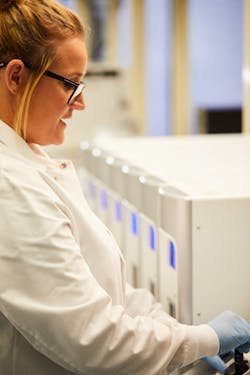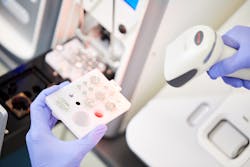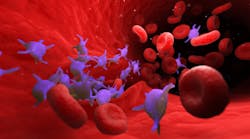To take the test online go HERE. For more information, visit the Continuing Education tab.
LEARNING OBJECTIVES
Upon completion of this article, the reader will be able to:
- Discuss statistics and factors that lead to bloodstream infections.
- Describe the limitations of culture-based testing of bloodstream infections.
- Discuss best treatment algorithms for suspected bloodstream infections.
- List and describe molecular-based testing for bloodstream infections, including their main advantages over culture-based testing.
While they may lack the public awareness of cancer or heart disease, bloodstream infections represent a significant health threat, killing millions of people around the world every year. Often associated with bacteria (leading to bacteremia), bloodstream infections can also do major damage by triggering the out-of-control inflammatory response that spirals into sepsis, another leading cause of morbidity and mortality among hospitalized patients.
Making matters worse, bloodstream infections acquired in hospital settings are often associated with bacterial strains resistant to one or more antibiotics.1 These drug-resistant and multi-drug-resistant bacteria are increasingly difficult to treat. Healthcare teams have the greatest chance of success when they can identify the pathogen’s drug-resistance profile as soon as possible to guide treatment selection based on known susceptibilities.
Because of the grave risk they confer to the patient, bloodstream infections must be diagnosed quickly and completely — identifying not only the causal pathogen but also its resistance mechanisms, all fast enough to adjust treatment in a clinically relevant time frame for optimal outcomes. Typically, the use of culture-based methods to generate all of this information takes several days, far too long to keep the patient out of danger.
Rapid molecular test options can be paired with a traditional culture workflow to generate results more quickly. These tests can also evaluate resistance mechanisms at the genotypic level, producing actionable information that can guide treatment selection much earlier. But not all molecular tests are equally reliable for bloodstream infections, and some do not include profiling of antibiotic susceptibility. Clinical laboratories may prefer molecular tests that allow for either direct-sample processing or PCR amplification to ensure optimal use with each sample. Multiple clinical utility and economic studies are now available to help pathologists and other laboratory personnel evaluate testing options and select the right one for the needs of their patient population.2
A look at bloodstream infections
Bloodstream infections can often be life-threatening. According to estimates, some 30 million people worldwide are diagnosed with bloodstream infections each year; of those, 6 million will die.3,4 Morbidity and mortality rates can be worse depending on factors about each patient, such as age and underlying health conditions, as well as traits specific to the causal pathogen, such as its antibiotic resistance profile. At the high end, mortality estimates range from 25% to 80%.5,6 Patients who receive effective antibiotics as early as possible in the infection fare significantly better than patients whose treatment is delayed.7,8
The majority of bacterial bloodstream infections are caused by Gram-positive bacteria; the most frequent culprits include Staphylococcus aureus, Enterococcus species, and coagulase-negative staphylococci.3,9,10 In about a third of hospital-acquired bloodstream infections, Gram-negative bacteria are responsible; these pathogens typically lead to mortality rates that are 15% to 29% higher than average, particularly when the bacterial strains are resistant to multiple types of antibiotics.11-18
As a result, timely diagnosis of the causal pathogen and profiling its antibiotic susceptibility to guide treatment selection are of the utmost importance in treating patients with bloodstream infections. Administering an effective treatment early in the infection offers significant advantages, not only for resolving the immediate infection but also for preventing the patient from progressing into sepsis and the many health risks associated with septic shock. Rapid treatment is correlated with shorter hospital stays and lower healthcare costs.
Typically, when a patient presents with symptoms of a bloodstream infection, doctors will consider several factors: any suspected source of the infection, the patient’s immune status, previous exposure to antibiotics or to drug-resistant bacteria, and the local epidemiological landscape.1 In most cases, the patient will be prescribed a cocktail of broad-spectrum antibiotics while samples are sent off to the laboratory for testing. As key data is reported by the lab — including the bacterial species and its antibiotic resistance profile — healthcare teams may adjust or de-escalate treatment, often switching patients to narrow-spectrum antibiotics or to antibiotics more likely to be effective against the pathogen as appropriate.
The shift from broad-spectrum to narrow-spectrum antibiotics is an important element in antimicrobial stewardship programs that aim to curb the spread of antibiotic resistance. The sooner patients can be switched to an effective narrow-spectrum antibiotic, the less risk there is for the development of antibiotic resistance. This has benefits not only for the patient with the bloodstream infection but also for other people, both inside the hospital and beyond, to whom drug-resistant bacteria could spread.
Pathogen testing options
The gold standard for diagnosing bloodstream infections and for providing a phenotypic readout of antibiotic susceptibility is culture-based testing. However, while culture can provide the necessary information for patient care, it cannot do so in a clinically actionable time frame. Generating results from standard culture approaches can take several days, with antibiotic susceptibility information taking even longer. By the time these results are reported back to treating physicians, the patient has likely been on broad-spectrum antibiotics for several days and there is little opportunity for an evidence-based switch to narrow-spectrum antibiotics in time to make a difference for the development of antibiotic resistance. In cases where the patient’s infection is caused by a pathogen resistant to all of the broad-spectrum antibiotics used in the original cocktail, that means the infection may go unchecked for several days before physicians learn the crucial details of its antibiotic resistance and susceptibility profile.
Molecular tests offer a number of advantages for clinical diagnostics. Most importantly, they can return results rapidly. In some cases, molecular tests for bloodstream infections can identify the causal pathogen and interrogate key mechanisms of antibiotic resistance, all in just a few hours. They are also amenable to multiplexing. Multiplex panels for bloodstream infections, for instance, might enable the detection of a dozen or so different species, groups, and genera — all from the same sample and in the same reaction, so that all results can be reported at once. These assays can reduce the time it takes to get a patient on an effective treatment, or to de-escalate to an appropriate treatment, by 24 to 48 hours. Because they enable faster effective treatment, the tests also mitigate the risk of developing sepsis.
Certain molecular tests offer another layer of flexibility by giving clinical laboratory users the option of direct-sample detection or amplification with PCR. These tests, all of which use the actual contents of the blood culture bottle, are designed to manage the risk of accidentally amplifying non-viable microbial fragments embedded in the culture media during the manufacturing process. If this is a concern, users can select a platform that performs direct-sample detection, bypassing the amplification step in order to minimize the risk of false results and ensure that rapid molecular results will be concordant with culture-based results. In cases where non-viable fragments in the culture media are not an issue, users can perform PCR amplification. Either way, results may be available in just two hours. Having the option can be helpful in increasing flexibility and allowing clinical lab professionals to determine the best technique for each sample.
Profiling antibiotic resistance
Antibiotic resistance — and even worse, multi-drug resistance — has become increasingly common among bacteria that cause bloodstream infections. This is part of a sweeping public health crisis: one analysis found that in 2019 alone, almost 1.3 million deaths worldwide were linked to bacteria with antibiotic resistance mechanisms.19
In the United States, many hospitals and other healthcare facilities have established antimicrobial stewardship programs tasked with one goal: reining in the spread of antibiotic resistance, particularly from hospital-associated infections. These teams consider a wide variety of factors, from isolation protocols to treatment selection algorithms and more, and shape practices throughout the clinical care process. According to the Centers for Disease Control and Prevention (CDC), these programs had recently begun to make a difference: from 2012 to 2017, deaths from drug-resistant infections decreased by 18%.20 That trend continued until 2020, but unfortunately the COVID-19 pandemic has reversed much of that progress.
Because of the escalating dangers of antibiotic resistance, healthcare teams sorely need information about the antibiotic susceptibility profile of any pathogen causing a bloodstream infection. Broadly, there are two distinct methods for generating this data: phenotypic and genotypic.
Culture-based techniques are the most popular because they produce phenotypic results that clearly indicate the infection-causing bacteria’s response to various treatment options, often at varying levels to assist with dosing recommendations. The drawback, of course, is that performing antibiotic susceptibility testing with culture takes several days or more than a week, depending on the growing time of the pathogen.
Genotypic approaches are more recent and have been gaining traction in clinical laboratories because they can generate results in just a few hours. They rely on known genetic mechanisms associated with drug resistance, such as the well-known mecA gene that makes Staphylococcus aureus resistant to methicillin and other antibiotics. Once these genes or genetic variants are identified in the research community, clinical labs can develop or adopt molecular assays to detect them in patient samples. Such workflows might be run on massively parallel DNA sequencers, PCR-based technologies, and commercially available kits based on a variety of testing platforms. These assays should detect all of the critical targets associated with antibiotic resistance. For bloodstream infections, where the causal pathogen is likely to be the only microbe in a patient’s blood sample, genotypic results are reliable and actionable.
Rapid profiling of a pathogen’s antibiotic susceptibility can help get a patient on the treatment most likely to be effective very quickly for optimal patient outcomes. Just as important, though, this information supports antimicrobial stewardship programs and provides a key tool in the battle against antibiotic resistance for better public health outcomes as well.
Ease-of-use matters
These automated systems generally handle all sample preparation and processing steps inside the instrument. Technicians simply take the patient’s sample, load it into a cartridge-like device, and insert it into the instrument. The sample-to-answer system will run all subsequent steps and then send a report of all results — such as pathogen identity and antibiotic resistance mechanisms — to the user.
Most sample-to-answer systems can process several samples at a time, fitting well into workflows at clinical labs requiring low- to mid-throughput platforms. In some cases, a single system can handle both stat and batch testing, allowing users to begin a new test while other samples are already in process.
Because they require so little human intervention, sample-to-answer systems significantly reduce the training burden on clinical lab teams. They can be a good choice for laboratories with unpredictable demand for testing or lean staff resources.
Clinical utility and economic studies
As molecular testing has become more readily available, a number of clinical laboratories have evaluated them in studies designed to assess clinical utility and economic impact.
For example, researchers at the University of Virginia Health System paired a rapid molecular assay designed for Gram-positive bloodstream infections with an infectious disease consultation.21 In their study of patients with bacteremia caused by S. aureus, they compared outcomes from a pre-implementation group of 106 patients diagnosed with conventional culture testing and standard management to a post-implementation group of 120 patients. In the post-implementation group, diagnosis was performed with rapid, panel-based testing; positive results automatically triggered a consultation with an infectious disease specialist. Analysis of the comparison showed that the rapid molecular assay approach shortened the patient’s time to consultation once a blood culture rang positive by 26 hours, and the time to beginning treatment with a targeted antibiotic was reduced by an average of more than 21 hours. Importantly, the time to switch patients to a targeted antibiotic for methicillin-sensitive cases of S. aureus decreased by more than 40 hours, on average. Mortality — both in the hospital and within 30 days — decreased significantly in the post-implementation group as well.
Another study, this one performed by researchers at the University of Maryland, aimed to evaluate the effects of rapid bloodstream infection diagnosis and antimicrobial stewardship efforts including a treatment algorithm.22 The study included 188 patients who had bloodstream infections caused by Gram-negative bacteria. Results showed that by using data from rapid molecular testing, algorithm-based treatment selection led to better-targeted antibiotics: antibiotic susceptibility for bacteria tested in vitro with an algorithm-selected therapy reached 92%, but fell to less than 78% for treatments selected by standard practices. Researchers determined that the algorithm would have made it possible for more than 88% of cases to get appropriate therapy compared to 78% with standard of care.
At the Cleveland Clinic, researchers conducted a large study of 877 patients with Gram-negative bacteremia — 456 treated prior to the implementation of rapid molecular testing and 421 treated after implementation.23 They assessed outcomes by measuring how long it took to change a patient’s antibiotic to a targeted treatment based on diagnostic and antibiotic susceptibility data. Patients in the pre-implementation group got antimicrobial changes about 44 hours after a Gram stain was performed, while patients in the post-implementation group had their therapies adjusted after less than 29 hours. For patients who were initially treated with an inappropriate therapy, time to receive an effective therapy (again starting the clock with the Gram stain) dropped from nearly 25 hours to less than 9 hours. The median hospital stay also decreased from 9 days to 7 days.
Similar studies also incorporate an economic element. At the Children’s Hospital Los Angeles, for instance, researchers collected information about hospital stay duration, hospital costs, and time to shift antibiotic treatment for 219 pediatric cases, gathering analogous data for 221 cases that had been treated prior to the adoption of rapid molecular diagnostics.24 In total, the team analyzed 440 Gram-positive bloodstream infection episodes for 383 patients. The incorporation of rapid testing led to a reduction of nearly 13 hours in getting patients on an optimized antimicrobial treatment. Patients who had been treated with antibiotics based on false-positive culture results caused by blood culture contaminants were taken off these inappropriate treatments nearly 37 hours sooner. In addition, the median duration of a hospital stay was cut by 1.5 days and the median hospital costs decreased by nearly $3,800. Those numbers were even more significant for infections caused by S. aureus: the median hospital stay was nearly six days shorter and about $13,000 less expensive.
In one final example, researchers at the University of Southern California reviewed outcomes for patients with Gram-negative bloodstream infections six months prior to and six months after adopting a rapid molecular panel test for bloodstream pathogens.25 The study included 98 patients diagnosed with standard methods and 97 patients diagnosed with the rapid assay. Between the two groups, there were no major differences in demographics — such as comorbidities, the cause of bacteremia, or immunosuppressive treatments. Samples tested with rapid diagnostics were also tested with traditional culture, and results showed that the rapid assay matched culture results in 98% of cases. Pathogen identification was performed more quickly with rapid testing, generating results at an average of 11 hours compared to nearly 38 hours for conventional testing. Length of stay in the ICU was also measured and found to be four days shorter for patients with rapid diagnostic results. Mortality rates at 30 days dropped by 11% in the rapid-result cohort; for patients with multidrug-resistant infections, 12.5% (one patient of eight) died in the rapid testing group compared to 63% (12 patients out of 19) in the conventional testing group. Researchers estimated that the availability of rapid results for bloodstream infection cases would lead to an average net savings of nearly $12,000 per ICU patient.
In review
For bloodstream infection testing, clinical laboratories must produce key data about the pathogen causing the infection as well as its antibiotic resistance profile — and do so quickly enough to make a difference in treatment selection for the patient. When patients with bloodstream infections get an effective treatment quickly, they have far better outcomes and are less likely to spiral into worse conditions such as sepsis.
While this kind of testing has traditionally been done with a culture-based process, the reality is that waiting days or more for results makes it impossible for physicians to fine-tune or de-escalate treatment in a timely manner. Today, clinical laboratories may shift to molecular methods that deliver results in just a few hours. Some of these molecular tests are designed to fit within the standard, culture-based workflow to make it easier for labs to incorporate these rapid assays.
For bloodstream infections, molecular tests can be designed to detect all common bacterial culprits. The same assay can also detect key antibiotic resistance mechanisms, producing clinically actionable results that in many cases can be reported back to treating physicians on the same day the sample is collected. Clinical laboratories may want to prioritize molecular assays that allow for both direct-sample and PCR amplification testing for increased flexibility with each sample, as well as sample-to-answer systems that offer a streamlined workflow.
References
- Timsit JF, Ruppé E, Barbier F, Tabah A, Bassetti M. Bloodstream infections in critically ill patients: an expert statement. Intensive Care Med. 2020;46(2):266–284. doi:10.1007/s00134-020-05950-6.
- Dunbar SA, Gardner C and Das S. Diagnosis and management of bloodstream infections with rapid, multiplexed molecular assays. Front. Cell. Infect. Microbiol. 2022;12:859935. doi:10.3389/fcimb.2022.859935.
- Wisplinghoff H, Bischoff T, Tallent SM, Seifert H, Wenzel RP, Edmond MB. Nosocomial bloodstream infections in US hospitals: analysis of 24,179 cases from a prospective nationwide surveillance study. Clin Infect Dis. 2004;39(3):309–317. doi:10.1086/421946.
- Fleischmann C, Scherag A, Adhikari NK, Hartog CS, Tsaganos T, Schlattmann P, et al. Assessment of global incidence and mortality of hospital-treated sepsis. Current estimates and limitations. Am. J. Respir. Crit. Care Med. 2016;193(3), 259–272. doi:10.1164/rccm.201504-0781OC.
- Kollef M. H., Zilberberg M D, Shorr AF, Vo L, Schein J, Micek ST, et al. Epidemiology, microbiology and outcomes of healthcare-associated and community-acquired bacteremia: A multicenter cohort study. J. Infect. 2011;62(2), 130–135. doi:10.1016/j.jinf.2010.12.009.
- Levy MM, Rhodes A, Phillips GS, Townsend SR, Schorr CA, Beale R, et al. (2014). Surviving sepsis campaign: Association between performance metrics and outcomes in a 7.5-year study. Intensive Care Med. 2014;40(11), 1623–1633. doi:10.1007/s00134-014-3496-0.
- Leibovici L, Shraga I, Drucker M, Konigsberger H, Samra Z, Pitlik SD. The benefit of appropriate empirical antibiotic treatment in patients with bloodstream infection. J. Intern. Med. 1998;244(5), 379–386. doi:10.1046/j.1365-2796.1998.00379.x.
- Kumar A, Roberts D, Wood KE, Light B, Parrillo JE, Sharma S, et al. Duration of hypotension before initiation of effective antimicrobial therapy is the critical determinant of survival in human septic shock. Crit. Care Med. 2006;34(6), 1589–1596. doi:10.1097/01.ccm.0000217961.75225.e9.
- Beekmann SE, Diekema DJ, Chapin KC, Doern GV. Effects of rapid detection of bloodstream infections on length of hospitalization and hospital charges. J. Clin. Microbiol. 2003;41(7), 3119–3125. doi:10.1128/jcm.41.7.3119-3125.2003.
- Grozdanovski K, Milenkovic Z, Demiri I, Spasovska K. Prediction of outcome from community-acquired severe sepsis and septic shock in tertiary-care university hospital in a developing country. Crit. Care Res. Pract. 2012:182324. doi:10.1155/2012/182324.
- Gaynes R, Edwards JR. Overview of nosocomial infections caused by Gram-negative bacilli. Clin. Infect. Dis. 2005;41(6), 848–854. doi: 10.1086/432803.
- Diekema D. J., Hsueh, P. R., Mendes, R. E., Pfaller, M. A., Rolston, K. V., Sader, H. S., et al. (2019). The Microbiology of Bloodstream Infection: 20-Year Trends From the SENTRY Antimicrobial Surveillance Program. Antimicrob. Agents Chemother. 63 (7), e00355–19. doi: 10.1128/aac.00355-19.
- Wisplinghoff, H., Seifert, H., Tallent, S. M., Bischoff, T., Wenzel, R. P., Edmond, M. B. (2003). Nosocomial Bloodstream Infections in Pediatric Patients in United States Hospitals: Epidemiology, Clinical Features and Susceptibilities. Pediatr. Infect. Dis. J. 22 (8), 686–691. doi: 10.1097/01.inf.0000078159.53132.40.
- Al-Hasan, M. N., Eckel-Passow, J. E., Baddour, L. M. (2012). Impact of Healthcare-Associated Acquisition on Community-Onset Gram-Negative Bloodstream Infection: A Population-Based Study: Healthcare-Associated Gram-Negative BSI. Eur. J. Clin. Microbiol. Infect. Dis. 31 (6), 1163–1171. doi: 10.1007/s10096-011-1424-6.
- Schwaber, M. J., Navon-Venezia, S., Kaye, K. S., Ben-Ami, R., Schwartz, D., Carmeli, Y. (2006). Clinical and Economic Impact of Bacteremia With Extended- Spectrum-Beta-Lactamase-Producing Enterobacteriaceae. Antimicrob. Agents Chemother. 50 (4), 1257–1262. doi: 10.1128/aac.50.4.1257-1262.2006.
- Patel, G., Huprikar, S., Factor, S. H., Jenkins, S. G., Calfee, D. P. (2008). Outcomes of Carbapenem-Resistant Klebsiella Pneumoniae Infection and the Impact of Antimicrobial and Adjunctive Therapies. Infect. Control Hosp. Epidemiol. 29 (12), 1099–1106. doi: 10.1086/592412.
- Kaye, K. S., Pogue, J. M. (2015). Infections Caused by Resistant Gram-Negative Bacteria: Epidemiology and Management. Pharmacotherapy 35 (10), 949–962. doi: 10.1002/phar.1636.
- Kern, W. V., Rieg, S. (2020). Burden of Bacterial Bloodstream Infection-a Brief Update on Epidemiology and Significance of Multidrug-Resistant Pathogens. Clin. Microbiol. Infect. 26 (2), 151–157. doi: 10.1016/j.cmi.2019.10.031.
- Antimicrobial Resistance Collaborators. Global burden of bacterial antimicrobial resistance in 2019: a systematic analysis. Lancet. 2022 Feb 12;399(10325):629-655. doi: 10.1016/S0140-6736(21)02724-0. Epub 2022 Jan 19. PMID: 35065702; PMCID: PMC8841637.
- COVID-19 and Antibiotic Resistance. Centers for Disease Control and Prevention. https://www.cdc.gov/drugresistance/covid19.html. Accessed August 19, 2022.
- Eby, J. C., Richey, M. M., Platts-Mills, J. A., Mathers, A. J., Novicoff, W. M., Cox, H. L. (2018). A Healthcare Improvement Intervention Combining Nucleic Acid Microarray Testing With Direct Physician Response for Management of Staphylococcus Aureus Bacteremia. Clin. Infect. Dis. 66 (1), 64–71. doi: 10.1093/cid/cix727.
- Claeys, K. C., Schlaffer, K. E., Heil, E. L., Leekha, S., Johnson, J. K. (2018b). Validation of an Antimicrobial Stewardship-Driven Verigene Blood-Culture Gram-Negative Treatment Algorithm to Improve Appropriateness of Antibiotics. Open Forum Infect. Dis. 5 (10), ofy233. doi: 10.1093/ofid/ofy233.
- Rivard, K. R., Athans, V., Lam, S. W., Gordon, S. M., Procop, G. W., Richter, S. S., et al. (2017). Impact of Antimicrobial Stewardship and Rapid Microarray Testing on Patients With Gram-Negative Bacteremia. Eur. J. Clin. Microbiol. Infect. Dis. 36 (10), 1879–1887. doi: 10.1007/s10096-017-3008-6.
- Felsenstein, S., Bender, J. M., Sposto, R., Gentry, M., Takemoto, C., Bard, J. D. (2016). Impact of a Rapid Blood Culture Assay for Gram-Positive Identification and Detection of Resistance Markers in a Pediatric Hospital. Arch. Pathol. Lab. Med. 140 (3), 267–275. doi: 10.5858/arpa.2015-0119-OA.
- Walker, T., Dumadag, S., Lee, C. J., Lee, S. H., Bender, J. M., Cupo Abbott, J., et al. (2016). Clinical Impact of Laboratory Implementation of Verigene BC-GN Microarray-Based Assay for Detection of Gram-Negative Bacteria in Positive Blood Cultures. J. Clin. Microbiol. 54 (7), 1789–1796. doi: 10.1128/jcm.00376-16








